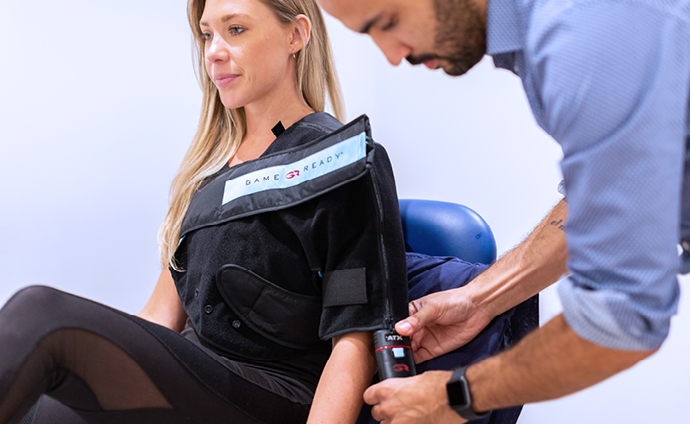Shoulders are one of the most complex parts of the body. Think about it — from lifting, to pushing, pulling and twisting, shoulders have a wide range of motion, meaning they are wonderfully flexible but also a little bit fragile. Plus, it is the only place where many joints (your arm bone, collarbone and shoulder blade specifically) all need to work together in order for your shoulder to be able to do its job.
So while it’s an impressive body part, these factors combined are why it’s also one of the most commonly injured areas in the body.
What is shoulder impingement?
Shoulder impingement is one of the most common shoulder issues that we see in Spectrum’s London clinic. It occurs when there is a lack of space in your shoulder capsule, which may be caused by a tendon, tissue or muscle rubbing against the joint when you move your arm in a certain direction, or other inflammation.
Other shoulder injuries — such as rotator cuff injuries, AC joint injuries or SLAP lesions — are quite common, so for this reason it can sometimes be tricky to diagnose exactly what is causing your shoulder pain, without a professional assessment from a physio. You can read more broadly about rotator cuff tears in one of our other articles .
What are the causes of shoulder impingement?
You may be wondering why on earth your shoulder has started impinging in the first place? Like any injury, it’s a case-by-case scenario and will depend on the individual, but generally speaking shoulder impingement will be caused by overdoing some sort of repetitive movement or poor posture.
Shoulder impingement can be caused by certain types of exercise or sports that involve a lot of overhead rotations like swimming, volleyball or tennis, but is also equally common in people with certain types of physical jobs that involve repetitive movements like labouring or even washing windows.
The other reason you may suffer from shoulder impingement could be genetics. If the tip of your shoulder blade is an unusual shape, it can mean you’ll be more likely to have issues as you get older.

What are some of the common symptoms of shoulder impingement?
When your shoulder impinges, the tendons will become swollen or injured and the fluid-filled sac between the tendons and bony tip of your shoulder blade can become inflamed.
Shoulder pain is the most telling sign of shoulder impingement and while you should always seek a proper assessment from a qualified physio to confirm your diagnosis, there are a few common types of pain to watch out for:
- Pain when you lift your arm above your head, or lower it back down from being raised.
- Pain in the front of your shoulder, which then may then be referred down the side of your arm.
- Pain when you put pressure on your shoulder, especially when lying in bed.
- Pain if you reach behind you, for example to get something out of your back pocket, or to do up your bra.
Arm weakness or stiffness may also occur but it’s important to keep in mind that this may not always be a symptom of shoulder impingement in isolation, but could be a combination of shoulder conditions. If you’re finding that you are experiencing extreme weakness in your arm (like can barely raise it at all sort of extreme), then it’s quite likely you have fully torn a muscle or tendon in addition to, or instead of, impingement. Or it could even be referred nerve pain from your neck.
Calcific tendonitis of the shoulder can also be related to shoulder impingement. This is when calcium deposits form on the tendons of your shoulder and become inflamed, which causes shoulder pain. Unfortunately, it is not entirely understood why this occurs, but when it does, the calcium build up takes up space between the rotator cuff tendon and the bony tip of your shoulder blade, which can then lead to impingement.
How can physiotherapy help fix your shoulder impingement?
Before starting any physiotherapy, we’ll always conduct a thorough assessment of your shoulder — and sometimes even refer you for a scan — to ensure that we have a clear diagnosis before devising a personalised treatment plan for you.
Once we know what we’re dealing with, here are some of the common treatment options we may rely on to fix your shoulder impingement:
1. Kinesiology tape or K-tape, as we often refer to it, is the perfect tape to use on shoulders, as it isn’t too rigid but will hold everything in place and guide your movement to help the healing process.
2. For acute patients we sometimes do rigid taping (as well as or instead of K-tape) to help offload the shoulder.
3. The GameReady Ice/Compression unit will reduce shoulder inflammation caused by impingement much faster than normal icing or compression can.
4. Dry Needling is an extremely effective treatment for joint pain such as shoulder impingement, reducing tension and tightness, which leads to less pain and more mobility.
5. TENS is an electrical nerve stimulation technology that helps you regain movement faster and reduce pain in an injured area, which is especially useful if your arm movement is impaired as well as being sore due to impingement.
6. Shockwave is appropriate for certain types of shoulder impingement. While historically it was normally only used on specific tendon injuries, newer research has proven it can be an effective treatment for impingement in some cases too.
Sick of dealing with shoulder pain? Book a time via our website and come in for an assessment and start your treatment plan ASAP.



